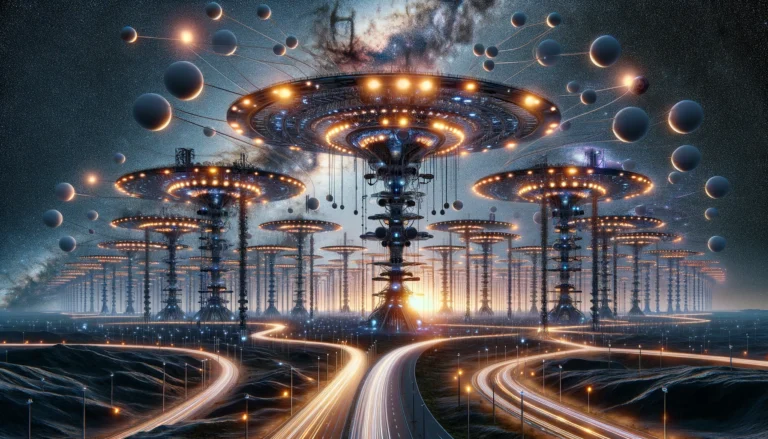Kardashev scale: Type I | Type II | Type III
Renewable and clean power output equals our galaxy: I have redefined Type III to shift from merely capturing the energy of a galaxy to utilizing energy sources that produce power equivalent to that of our entire galaxy. This adaptation moves beyond the traditional focus on megastructures like Dyson Spheres or Swarms encasing multiple stars and opens possibilities for advanced galactic energy management methods.
Since Einstein’s equation E=mc2 suggests that energy and matter are interchangeable, at this stage, civilizations could theoretically convert galactic matter into energy efficiently enough to produce power on a galactic scale. Using AI-controlled robots with nearly unlimited energy, they could gather materials, reproduce an army of robots, send them to the next source, while finishing up harnessing the current materials. This might include advanced forms of energy production such as harnessing the rotational energy of the galaxy, utilizing the gravitational forces of supermassive black holes, and perhaps the theoretical extraction of energy from dark matter or dark energy, which remain speculative but represent the frontier of cosmic-scale energy management.
According to the original definition, a Type III civilization represents an extraordinary leap in technological and energy management capabilities, where a civilization harnesses the energy output equivalent to that of its entire galaxy. This achievement would likely involve not just constructing but also managing complex networks of energy harvesters throughout the galaxy, potentially linking star systems with vast arrays of energy transmitters and receivers.
This interpretation of the original concept lends credibility to my modifications of Type I and II towards the notion of equivalent energy. At the very least, considering that Type III may involve harnessing energy equivalent to all outputs within a galaxy, my adjustments to Type I and II represent a logical extension rather than a radical departure from Kardashev’s original ideas.
Reach: Homo sapiens extend beyond our solar system to inhabit large, redundant space stations throughout this quadrant of the Milky Way galaxy and around its stars. While agreements among factions have kept most populations genetically similar, advancing as a collective when consensus is reached, interactions—including agreements and conflicts—with renegade groups that have evolved into different species are now commonplace. This includes the occassional major war.
Most scientists believe that evolutionary forces are abundant and common in life throughout the universe, leading many to posit that intelligent life has already evolved and is abundant across the cosmos. If these assertions hold true, this stage of human expansion would likely involve interactions not just with divergent human groups but also with extraterrestrial civilizations. These encounters could range from peaceful exchanges to conflicts, echoing the historical interactions among different Homo species on Earth. Such interstellar interactions, including occasional major wars, might become a regular aspect of life, as humanity navigates the complex dynamics of a galaxy inhabited by multiple intelligent species, each with its own culture, technology, and territorial claims.
Effects: With energy on a galactic scale essentially limitless, humanity could experience unprecedented advancements in living standards, technological capabilities, and cosmic exploration. With this level of access to energy, the possibilities for innovation and creativity could be boundless, likely driving monumental advancements in technology and enabling the development of societies across different star systems. The potential for constructing megastructures, inhabiting and terraforming new worlds, and possibly even manipulating the fundamental forces of the universe could become feasible.
The widespread availability of such energy could lead to a significant transformation in how civilizations view and distribute resources, potentially eradicating energy scarcity and dramatically reducing inequalities across star systems. As societies become interconnected through advanced galactic travel and communication technologies, a unified intergalactic cultural identity might emerge, profoundly changing our understanding of community and cooperation on a cosmic scale.
Estimates: While traditional estimates for achieving Type III status suggest hundreds of thousands to millions of years, focusing on producing equivalent energy rather than capturing all of a galaxy’s output could potentially shorten this timeline.
With the aid of previous advancements, type III might be acheivable in just 10,000 years from now. This relies on exponential growth in previous technologocal advancements. This optimistic scenario relies on exponential advancements in energy, quantum computing, AI, robotics, and other yet-to-be-invented technologies. This envisions a future where energy and our current obstables are not a limiting factor for civilizational development.











